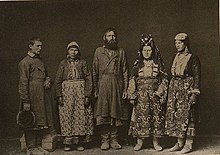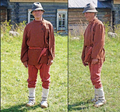 Flag of Udmurtia Flag of Udmurtia | |
 Udmurt children wearing traditional outfits during a flower festival in Igrinsky, Udmurtia, Russia (2019) Udmurt children wearing traditional outfits during a flower festival in Igrinsky, Udmurtia, Russia (2019) | |
| Total population | |
|---|---|
| 396,000 (2021) | |
| Regions with significant populations | |
| Udmurtia | |
| 386,465 (2021) | |
| 5,824 (2009) | |
| 4,712 (2001) | |
| 193 (2011) | |
| 179–197 (2023) | |
| Languages | |
| Udmurt, Russian | |
| Religion | |
| Majority: Russian Orthodoxy Minority: Udmurt Vos Protestantism Pentecostalism Islam | |
| Related ethnic groups | |
| Other Permians, especially Besermyan | |
The Udmurts (Udmurt: Удмуртъёс, Udmurtjos) are a Permian (Finno-Ugric) ethnic group in Eastern Europe, who speak the Udmurt language. They mainly live in the republic of Udmurtia in Russia.
Etymology
The name Udmurt comes from *odo-mort 'meadow people,' where the first part represents the Permic root *od(o) meaning 'meadow, glade, turf, greenery'. The second part, murt, means 'person' (cf. Komi mort, Mari mari, Mordvin mirď-), probably an early borrowing from an Iranian language (such as Scythian): *mertä or *martiya meaning 'person, man' (cf. Persian mard). This, in turn, is thought to have been borrowed from the Indo-Aryan term *maryá- 'man', literally 'mortal, one who is bound to die' (< PIE *mer- 'to die'), compare Old Indic márya 'young warrior' and Old Indic marut 'chariot warrior', both connected specifically with horses and chariots. This is supported by a document dated 1557, in which the Udmurts are referred to as lugovye lyudi 'meadow people', alongside the traditional Russian name otyaki.
On the other hand, in the Russian tradition, the name 'meadow people' refers to the inhabitants of the left bank of a river in general. Most relevant in this regard is the recent theory proposed by V. V. Napolskikh and S. K. Belykh, who suppose that the ethnonym was borrowed from Proto-Iranian entirely: *anta-marta meaning 'resident of outskirts, border zone' (cf. Antes) → Proto-Permic *odə-mort → Udmurt udmurt.
During the course of the Russian Empire, Udmurts have been referred to mainly as Chud Otyatskaya (чудь отяцкая), Otyaks, Wotyaks or Votyaks, all being exonyms. Today such exonyms are considered offensive by Udmurts themselves and are mainly used against those who have forgotten the Udmurt language. The Udmurts are closely related to Komis to their north, both linguistically and culturally.
Distribution

Most Udmurt people live in Udmurtia. Small groups live in the neighboring areas of Kirov Oblast and Perm Krai, Bashkortostan, Tatarstan, and Mari El.
The Udmurt population is shrinking; the Russian Census reported 552,299 in 2010, down from the 2002 Russian census figure of 637,000, in turn down from 746,562 in 1989. The 2021 census counted fewer Udmurts than had the 1926 census.
| Census | 1926 | 1939 | 1959 | 1970 | 1979 | 1989 | 2002 | 2010 | 2021 |
|---|---|---|---|---|---|---|---|---|---|
| Population | 503,970 | 599,893 | 615,640 | 678,393 | 685,718 | 714,883 | 636,906 | 552,299 | 386,465 |
| Percentage | 0.54% | 0.55% | 0.52% | 0.52% | 0.50% | 0.49% | 0.45% | 0.40% | 0.30% |
Culture
See also: Udmurt cuisine

The Udmurt language belongs to the Uralic family.
The Udmurts have a national epic called Dorvyzhy. Their national musical instruments include the krez zither (similar to the Russian gusli) and a pipe-like wind instrument called the chipchirghan.
A chapter in the French Description de toutes les nations de l'empire de Russie from 1776 is devoted to the description of the Wotyak people. James George Frazer also mentions a rite performed by the people in his book The Golden Bough.
Many Udmurt people have red hair, and a festival to celebrate the red-haired people has been held annually in Izhevsk since 2004.
The Udmurts used to be semi-nomadic forest dwellers that lived in riverside communities. However, most Udmurts now live in towns. Although the clan-based social structure of the Udmurts no longer exists, its traces are still strong and it continues to shape modern Udmurt culture.
Genetics
According to the data gathered by Kristiina Tambets and others (2018), the majority (about 70 %) of Udmurt men carry the haplogroup N. The high frequency of this East Eurasian-related haplogroup is a common pattern among Uralic-speaking peoples. Most Udmurt men belong to the subclade N1c and 16.8 percent of them belong the subclade N1b-P43. The second most common Y-DNA haplogroup among Udmurts is R1a (19 %).
The most common maternal haplogroup for Udmurts is U (23.5%). Most Udmurts who have it belong to its subclades U2 (10.4 %) and U5 (9.3 %). Nearly as common is H (22.5 %). Other mtDNA haplogroups among Udmurts include T (16.5 %), D (11 %) and Z (6 %).

When it comes to the autosomal ancestry of Udmurts, around 30 percent of it is Nganasan-like. This Siberian component is typical for Uralic-speaking peoples. The rest can be modelled to be mostly Steppe-like with a smaller eastern hunter-gatherer component, or Srubnaya-like. It is common for Northeastern Europeans to have a high level of Steppe-related admixture.
Gallery
- Wikimedia Russia director Vladimir Medeyko congratulates Udmurt language
-
 Udmurt women in traditional clothing
Udmurt women in traditional clothing
-

-
 An Udmurt man wearing traditional clothing
An Udmurt man wearing traditional clothing
-
 Udmurt girls at the Italmas Nuk flower festival in Igrinsky District
Udmurt girls at the Italmas Nuk flower festival in Igrinsky District
See also
- Besermyan (considered a subgroup of the Udmurts)
References
- State statistics committee of Ukraine - National composition of population, 2001 census (Ukrainian)
- RL0428: Rahvastik rahvuse, soo ja elukoha järgi, 31. detsember 2011
- "Population by ethnicity at the beginning of year – Time period and Ethnicity | National Statistical System of Latvia". data.stat.gov.lv.
- Latvijas iedzīvotāju sadalījums pēc nacionālā sastāva un valstiskās piederības, 01.01.2023. - PMLP
- "Главная страница проекта "Арена" : Некоммерческая Исследовательская Служба "Среда"".
- "IZ-article". Archived from the original on 2018-02-01.
- "Udmurtiya | Republic in Russia, Culture & History | Britannica". www.britannica.com. Retrieved 2024-01-05.
- "уд | это... Что такое уд?".
- Christopher I. Beckwith. Empires of the Silk Road: A History of Central Eurasia from the Bronze Age to the Present. Princeton: Princeton University Press. 2009. Page 397.
- A.G. Ivanov, "Udmurty – 'Lugovye lyudi'", Linguistica Uralica Vol. 27, No. 3 (1991), pp. 188–92.
- Белых С. К., Напольских В. В. Этноним удмурт: исчерпаны ли альтернативы? Linguistica Uralica. T. 30, № 4. Tallinn, 1994.
- ^ Müller, C. G. (1776). "Les Wotyaks". Description de toutes les nations de l'empire de Russie (in French). St. Petersburg. p. 65.
- Vitaly Michka (1 October 1994). Inside the New Russia. SC Publishing. ISBN 978-1-885024-17-6. Retrieved 17 June 2012.
- Frazer, James George (1913). The Golden Bough. Cambridge U. Press. p. 155. ISBN 978-1-108-04738-8.
Annual expulsion of Satan among the Wotyaks of Russia
- Mapped: Which countries have the most redheads? - The Telegraph
- The people with the reddest hair in the world - BBC News
- Рыжий фестиваль - 2017 - Izhevsk city portal
- Winston, Robert, ed. (2004). Human: The Definitive Visual Guide. New York: Dorling Kindersley. p. 396. ISBN 0-7566-0520-2.
- ^ Tambets, Kristiina; Yunusbayev, Bayazit; Hudjashov, Georgi; Ilumäe, Anne-Mai; Rootsi, Siiri; Honkola, Terhi; Vesakoski, Outi; Atkinson, Quentin; Skoglund, Pontus; Kushniarevich, Alena; Litvinov, Sergey; Reidla, Maere; Metspalu, Ene; Saag, Lehti; Rantanen, Timo (2018). "Genes reveal traces of common recent demographic history for most of the Uralic-speaking populations". Genome Biology. 19 (1): 139. doi:10.1186/s13059-018-1522-1. ISSN 1474-760X. PMC 6151024. PMID 30241495.
- Kushniarevich, Alena; Utevska, Olga; Chuhryaeva, Marina; Agdzhoyan, Anastasia; Dibirova, Khadizhat; Uktveryte, Ingrida; Möls, Märt; Mulahasanovic, Lejla; Pshenichnov, Andrey; Frolova, Svetlana; Shanko, Andrey; Metspalu, Ene; Reidla, Maere; Tambets, Kristiina; Tamm, Erika (2015-09-02). "Genetic Heritage of the Balto-Slavic Speaking Populations: A Synthesis of Autosomal, Mitochondrial and Y-Chromosomal Data". PLOS ONE. 10 (9): e0135820. Bibcode:2015PLoSO..1035820K. doi:10.1371/journal.pone.0135820. ISSN 1932-6203. PMC 4558026. PMID 26332464.
- ^ Jeong, Choongwon; Balanovsky, Oleg; Lukianova, Elena; Kahbatkyzy, Nurzhibek; Flegontov, Pavel; Zaporozhchenko, Valery; Immel, Alexander; Wang, Chuan-Chao; Ixan, Olzhas; Khussainova, Elmira; Bekmanov, Bakhytzhan; Zaibert, Victor; Lavryashina, Maria; Pocheshkhova, Elvira; Yusupov, Yuldash (2019). "The genetic history of admixture across inner Eurasia". Nature Ecology & Evolution. 3 (6): 966–976. Bibcode:2019NatEE...3..966J. doi:10.1038/s41559-019-0878-2. ISSN 2397-334X. PMC 6542712. PMID 31036896.
Further reading
- Klabukov, A. "Udmurtskije narodnyje skazki". Vstupitel'naja stat'ja P. Jasina, kommentarii A. Zapadova. Izevsk: 1948.
- Kralina, Nadezhda [ru]. "Сто сказок удмуртского народа" . Ижевск: Удмуртское книжное издательство, 1961.
- Levin, Isidor (1962). "III. Forschungsberichte: Die Volkserzählungen der Wotjaken (Udmurten) (Mit Beiträgen von Walter Anderson)". Fabula (in German). 5: 101–155. doi:10.1515/fabl.1962.5.1.101.
- Shushakova, Galina. "The Idea of Earthly and Unearthly worlds in the Udmurt fairy-tales". In: Folk Belief Today. Edited by Mare Kõiva and Kai Vassiljeva. Tartu: Estonian Academy of Sciences; Institute of Estonian Language; Estonian Museum of Literature, 1995. pp. 442-446. ISBN 9985-851-11-0.
External links
- Udmurtology—(in Russian)
- Udmurt language Misplaced Pages
| Peoples speaking Uralic languages | |
|---|---|
| Baltic Finns | |
| Sámi | |
| Volga Finns | |
| Permians | |
| Ob-Ugrians | |
| Hungarians | |
| Samoyeds | |